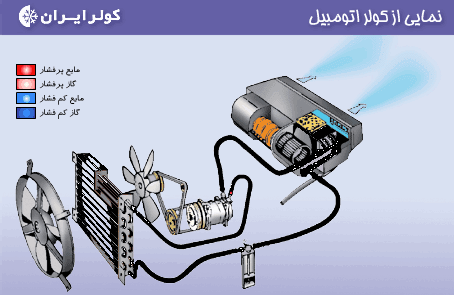
A/C System
Here you can get familiar with the main components of A/C system:
Compressor
The compressor is the propelling element for the refrigerant in the A/C system. A compressor circulates the refrigerant in the system and it acts as the heart of A/C. It also raises the pressure and then the temperature of the gaseous refrigerant, coming from the evaporator at low pressure and temperature. The compressor moves the refrigerant from evaporator, through the condenser via a receiver and expansion valve, right back to the evaporator.
Compressors used in the automotive A/C systems must be compact in dimension and lightweight in order to permit easy installation when the available space is limited and so as to overload the relative vehicle's suspensions.
Condenser
The condenser is the heat exchanger which is used to subtract the heat absorbed in the evaporator, from the refrigerant circulating inside the A/C system.
Receiver
The receiver dryer acts as a sort of reservoir for the refrigerant, and dehumidifier (drier) of the refrigerant. Normally, it has got a safety pressure switch and a sight glass mounted on the top. This sight glass allows us to check for adequate gas in the system.
Expansion Valve
The expansion valve determines the correct amount of refrigerant going into the evaporator from the condenser through the filter, and it lowers the pressure of the refrigerant drastically. When the compressor starts, the expansion valve opens and the liquid refrigerant flows through a strainer in the high-pressure liquid inlet once in the expansion valve, the refrigerant is properly pressurized.
As the evaporator calls for more refrigerants, the expansion valve allows the required amount of low-pressure liquid refrigerant into the coils. The expansion valve maintains the delicate balance between the heat load and the cooling efficiency of the evaporator.
Here you can get familiar with the main components of A/C system:
Compressor
The compressor is the propelling element for the refrigerant in the A/C system. A compressor circulates the refrigerant in the system and it acts as the heart of A/C. It also raises the pressure and then the temperature of the gaseous refrigerant, coming from the evaporator at low pressure and temperature. The compressor moves the refrigerant from evaporator, through the condenser via a receiver and expansion valve, right back to the evaporator.
Compressors used in the automotive A/C systems must be compact in dimension and lightweight in order to permit easy installation when the available space is limited and so as to overload the relative vehicle's suspensions.
Condenser
The condenser is the heat exchanger which is used to subtract the heat absorbed in the evaporator, from the refrigerant circulating inside the A/C system.
Receiver
The receiver dryer acts as a sort of reservoir for the refrigerant, and dehumidifier (drier) of the refrigerant. Normally, it has got a safety pressure switch and a sight glass mounted on the top. This sight glass allows us to check for adequate gas in the system.
Expansion Valve
The expansion valve determines the correct amount of refrigerant going into the evaporator from the condenser through the filter, and it lowers the pressure of the refrigerant drastically. When the compressor starts, the expansion valve opens and the liquid refrigerant flows through a strainer in the high-pressure liquid inlet once in the expansion valve, the refrigerant is properly pressurized.
As the evaporator calls for more refrigerants, the expansion valve allows the required amount of low-pressure liquid refrigerant into the coils. The expansion valve maintains the delicate balance between the heat load and the cooling efficiency of the evaporator.
Evaporator
The only other main part of the system is the evaporator unit. It is the A/C system component that has the function of removing heat from air injected into the cabin. Another very important function performed by the evaporator is that of dehumidifying the conditioned air.
The evaporator is in front of a fan. The fan pulls out the hot, humid air of the car's cabin. The refrigerant makes the hot air's moisture condense into drops of water, removing the heat from the air. Once water is removed, the "cool" air is sent back inside the car. The system has two built in switches, one that stops the compressor if the pressure is too low, and one that prevents ice from forming on the cold evaporator, as both of these faults can damage the system.




